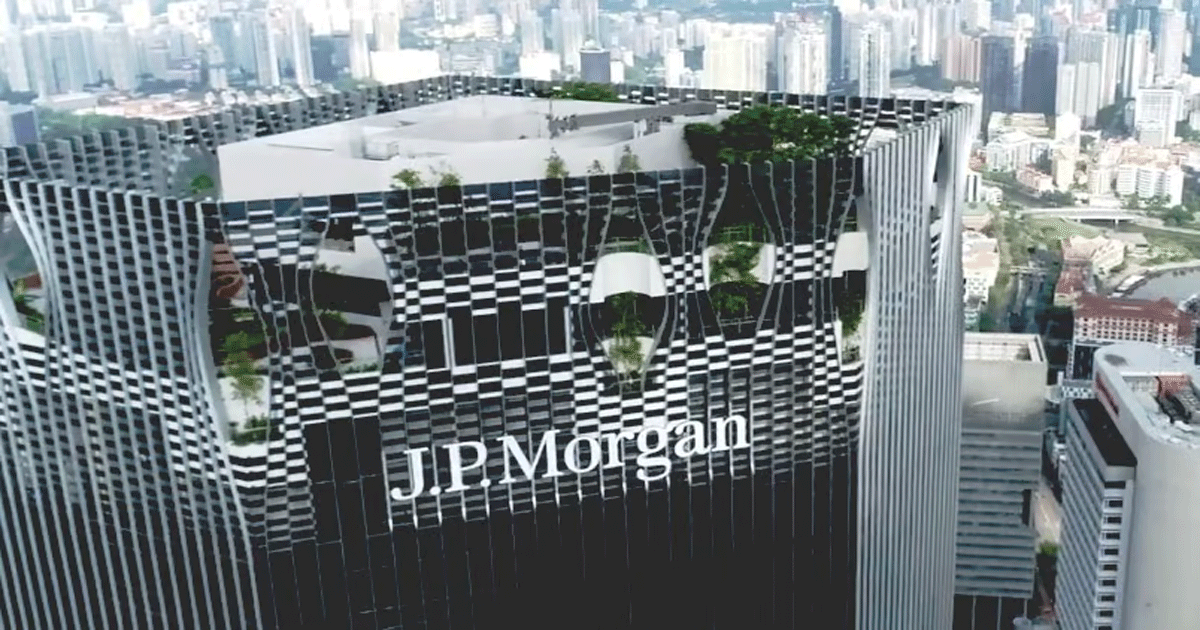Business
MAS Slaps Penalty Of SGD 2.4 Million On JP Morgan Chase Bank For Misconduct By Relationship Managers In 24 Bond Transactions

The Monetary Authority of Singapore (MAS) has imposed a civil penalty of SGD 2.4 million on JPMorgan Chase Bank, N.A. (JPM), according to a media release issued by the central bank of Singapore. The penalty was for JPMorgan Chase Bank failing to prevent and detect misconduct committed by its relationship managers (RMs).
The media release said: “In 24 over-the-counter (OTC) bond transactions, the RMs had made inaccurate or incomplete disclosures to clients, resulting in the clients being charged spreads that were above the bilaterally agreed rates.” These transactions took place between November 2018 and September 2019, said MAS.
Explaining that the RMs of JPMorgan Chase Bank had misled the clients into paying more than what they should have paid, MAS said that “JPM did not establish adequate processes and controls to ensure that its RMs adhered to pre-agreed spreads with clients when executing OTC bond transactions on their behalf”.
The central bank “sampled OTC bond transactions conducted by JPM’s RMs” and found that in the 24 transactions, the RMs had “either misrepresented the price components or omitted material information that the spreads charged were above the agreed rates”. The phrase “price components” refers to the executed interbank price and/or spread charged.
MAS said that this misrepresentation and omission by the RMs was “in contravention of sections 201(c) and 201(d) of the Securities and Futures Act (SFA)”.
Informing that the private bank had accepted these violations and its responsibility for what the relationship managers did, MAS said: “JPM has admitted liability under section 236C of the SFA for its failure to prevent or detect the misconduct by its RMs and has paid MAS the civil penalty. The bank has refunded the overcharged fees to affected clients.”
At the same time, JPMorgan Chase Bank has taken measures to prevent a repeat of this. “The bank has also enhanced its pricing frameworks and internal controls to prevent the recurrence of such misconduct,” said MAS. “Separate reviews into the individual RMs involved in the misconduct are ongoing.”
What is the MAS civil penalty?
“A civil penalty action is not a criminal action and does not attract criminal sanctions. The civil penalty regime, designed to complement criminal sanctions and provide a nuanced approach to combat market misconduct, became operational at the beginning of 2004,” said the MAS media release.
“Under section 232 of the SFA, MAS may enter into an agreement with any person for that person to pay, with or without admission of liability, a civil penalty for contravening any provision of Part 12 of the SFA. The civil penalty may be up to three times the amount of the profit gained or loss avoided by that person as a result of the contravention, subject to a minimum of USD 50,000 (if the person is not a corporation) or $100,000 (if the person is a corporation).”
Under section 201(c) of the SFA, no person shall, directly or indirectly, in connection with the subscription, purchase or sale of any capital market products, make any statement he knows to be false in a material particular.
● Section 201(d) of the SFA
Under section 201(d) of the SFA, no person shall, directly or indirectly, in connection with the subscription, purchase or sale of any capital market products, omit to state a material fact necessary in order to make the statements made, in the light of the circumstances under which they were made, not misleading.
● Section 236C of the SFA
Under section 236C of the SFA, a corporation which fails to prevent or detect a contravention of any provision in Part 12 of the SFA that is committed by an employee or officer for its benefit and attributable to its negligence, commits a contravention and shall be liable to an order for a civil penalty.
Business
Nifty surges over 1 pc this week led by bank, auto stocks

SHARE MARKET
Mumbai, Jan 3: The Indian equity benchmarks closed on a strong note this week, touching fresh all-time highs amid strong performance in the banking and auto sectors.
Nifty surged 1.05 per cent during the week and 0.70 per cent on the last trading day to 26,328. At close, Sensex was up 760 points or 0.67 per cent at 85,762. It surged 0.89 per cent during the week.
Bank Nifty also continued its outperformance and scaled fresh record highs above the 60,200 mark.
The Indian equities traded in a cautious tone till New Year, weighed down by persistent FII outflows and heightened global uncertainties. On New Year, the indices ended on a flat note, and on the last day of trading week, they touched fresh all-time highs.
Strong momentum was observed in the auto and PSU banking sectors, while sectoral rotation was evident in utilities as they gained traction on hopes of rising demand and increased industrial activity. Robust December auto sales indicate a broader uptick in economic activity during the festive-driven quarter.
Improving asset quality and expectations of accelerated credit growth drew investor interest toward PSU banking stocks, analysts said.
Conversely, FMCG index dipped 4 per cent for the week after the government announced a higher excise duty on cigarettes.
Broader indices outperformed benchmark indices for the week, with the Nifty Midcap100 up 1.74 per cent, while Nifty Smallcap100 edged up 0.77 per cent.
Precious metals continued their momentum, as trade disparity, supply constraints, geo-political tension, rate cut view and FII outflows continue to test the near-term risk appetite of investors.
According to analysts, a sustained hold by Nifty above 26,300 could accelerate the rally toward 26,500, with an extended upside potential toward 26,700 on strong follow-through. Bank Nifty is likely to continue outperforming the Nifty index in the near term, they added.
Key cues for investors going forward include US payroll and unemployment data for global market direction. Markets may move within a steady range as participants wait for clearer earnings‑led triggers and clarity on the India-US trade deal, market watchers said.
Business
New labour codes bring on board gig workers with 90-day employment

New Delhi, Jan 2: The Ministry of Labour and Employment has published the draft rules for the four labour codes, which also bring gig workers on board for various benefits such as minimum wage, health, occupational safety, and social security coverage.
The government has invited feedback from stakeholders on these draft rules and aims to finally roll out the entire package of four labour codes across the country from April 1.
Under the draft rules, in order to be eligible for the benefits, a gig or platform worker must be associated with an aggregator for at least 90 days in a financial year to qualify for social security benefits created by the Centre. If a worker is engaged with more than one aggregator, the minimum requirement is fixed at 120 days.
The notification, dated December 30, 2025, was issued a day before the gig and platform workers went on a flash strike for higher wages and better working conditions.
The rules clarify that a worker is considered “engaged” on any calendar day if they earn income for work done for an aggregator, regardless of how much they earn.
If a worker is associated with multiple aggregators, the number of engagement days will be added together across all aggregators. The draft also states that if a worker is engaged with three aggregators on the same calendar day, it will be counted as three separate days of engagement.
Regarding the minimum wage, the draft rules state that when the rate of wages for a day is fixed, then such amount shall be divided by eight for fixing the rate of wages for an hour and multiplied by twenty-six for fixing the rate of wages for a month. In case of a five-day working week, the hourly rate of minimum wages so calculated shall be used to derive the minimum wages for the day.
While fixing the minimum rates of wages, the Central government shall take into account the geographical area, experience in the area of employment, and level of skill required for working under the categories of unskilled, semiskilled, skilled, and highly skilled, the rules further state.
The four codes — the Code on Wages, 2019; the Industrial Relations Code, 2020; the Code on Social Security, 2020; and the Occupational Safety, Health and Working Conditions Code, 2020 — were notified on the same day.
The Labour Codes make it mandatory for employers to issue appointment letters to all workers, which provides written proof to ensure transparency, job security, and fixed employment. Earlier, no mandatory appointment letters were required.
Under the Code on Social Security, 2020, all workers, including gig and platform workers, will get social security coverage. All workers will get PF, ESIC, insurance, and other social security benefits. Earlier, there was only limited security coverage.
Under the Code on Wages, 2019, all workers will receive a statutory minimum wage payment, and timely payment will ensure financial security. Earlier, minimum wages applied only to scheduled industries or employments and large sections of workers remained uncovered.
Business
FAIFA urges government to roll back steep tax hike on tobacco products

New Delhi, Jan 2: The Federation of All India Farmer Associations (FAIFA) on Friday urged the government to roll back the notified excise rates on tobacco products and revise them to revenue-neutral rates, to disincentivise smuggling, and support domestic agriculture.
A stable taxation framework, FAIFA noted in a statement, is necessary to sustain farmer incomes, protect employment across the value chain, and align economic policy with long-term public health goals.
The Ministry of Finance notification ‘Chewing Tobacco, Jarda Scented Tobacco and Gutkha Packing Machines (Capacity Determination and Collection of Duty) Rules, 2026’ has imposed an excise duty of Rs 2,050-Rs 8,500 per 1,000 sticks, depending on cigarette length, effective February 1.
FAIFA said such a steep hike in taxes would force domestic manufacturers to raise prices of finished goods, which will lead to a drop in sales, hurting farmers supplies in return. This could cause a glut in the tobacco crop market in the near term, it added.
“While announcing GST 2.0 on September 4, 2025, Government had assured that in the case of tobacco products, GST would be charged at 40 per cent of the retail sales price, while the overall incidence of tax would be kept unchanged,” said Murali Babu, President, FAIFA.
He further added that the farming community across India has been holding on to this assurance of revenue neutrality and had welcomed the government’s decision to rationalise GST by restructuring rates and doing away with the 12 per cent slab, which helped reduce prices.
Appealing to the government, FAIFA leaders stressed that India’s legal cigarette prices are already among the least affordable globally when measured against per capita income, as reflected in World Health Organization’s (WHO) affordability index.
Current steep increase will render legal products unaffordable to a huge section of consumers, accelerating consumer migration to illegal channels, it argued. FAIFA appealed to the government to ensure that taxation policies do not punish those who have always remained within the law.
-

 Crime3 years ago
Crime3 years agoClass 10 student jumps to death in Jaipur
-

 Maharashtra1 year ago
Maharashtra1 year agoMumbai Local Train Update: Central Railway’s New Timetable Comes Into Effect; Check Full List Of Revised Timings & Stations
-

 Maharashtra1 year ago
Maharashtra1 year agoMumbai To Go Toll-Free Tonight! Maharashtra Govt Announces Complete Toll Waiver For Light Motor Vehicles At All 5 Entry Points Of City
-

 Maharashtra1 year ago
Maharashtra1 year agoFalse photo of Imtiaz Jaleel’s rally, exposing the fooling conspiracy
-

 National News1 year ago
National News1 year agoMinistry of Railways rolls out Special Drive 4.0 with focus on digitisation, cleanliness, inclusiveness and grievance redressal
-

 Maharashtra1 year ago
Maharashtra1 year agoMaharashtra Elections 2024: Mumbai Metro & BEST Services Extended Till Midnight On Voting Day
-

 National News1 year ago
National News1 year agoJ&K: 4 Jawans Killed, 28 Injured After Bus Carrying BSF Personnel For Poll Duty Falls Into Gorge In Budgam; Terrifying Visuals Surface
-

 Crime1 year ago
Crime1 year agoBaba Siddique Murder: Mumbai Police Unable To Get Lawrence Bishnoi Custody Due To Home Ministry Order, Says Report












